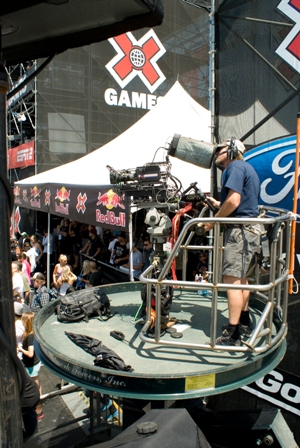ESPN Gears Up for 3D X Games
LOS ANGELES—Following its 3D production success with the Winter X Games Aspen 2012, ESPN will produce the summer X Games 18 in Los Angeles, June 28-July 1, completely in 3D for the ESPN 3D channel.
“Just as we did in Aspen, every event at the Summer X Games will be shot and transmitted in 3D,” said Phil Orlins, ESPN’s X Games Coordinating Producer. “When you see the HD version of our coverage, bear in mind that you will be watching one of the two HD feeds that comprise the 3D telecast. It will have been downconverted from 3D; just as we used to downconvert HD to SD years ago.”
A DAUNTING SET OF VENUES
Whether they employ a pair of HDTV broadcast cameras on a T-bracket, or a “beam splitter,” each 3D camera is a complex marriage of optics and electronics. In the same vein, 3D cameras are less forgiving of fast pans and cuts than their 2D cousins are. “Shooting in 3D requires more finesse and care than 2D does,” Orlins tells TV Technology.

Camera positioning and shooting views have to be well-planned and tailored for each sport's visual eccentricities at the X Games. Unfortunately for ESPN—but fortunately for its viewers—the Summer X Games don’t give much margin for finesse. With six extreme sports spread across six venues—including LA’s Staples Center—the network’s camera crews will be kept hopping. Meanwhile, action sports such as skateboarding, BMX bike-riding and rally car racing are anything but slow and predictable. Camera positioning and shooting have to be well-planned and tailored for each sport’s visual eccentricities; be it the airborne moves of skateboarders or the hair-raising leaps of BMX bikers.
“For instance, an HDTV camera with a super-telephoto lens is well suited for detailed extreme distance shots,” Orlins said. “And since depth of field doesn’t really stand out in such shots, the viewers don’t notice that they are not in 3D.”
PROVEN PRODUCTION SETUP
Thanks to their pioneering work in live 3D sports coverage, ESPN has become a veteran in shooting such events. As a result, the network knows what works. In this case, it is the same production setup that they used so successfully in Aspen for the Winter X Games.
“We will be shooting the Summer X Games using matched pairs of Sony HDC1500 cameras configured for 3D, using Cameron Pace Group 3D rigs,” Orlins said. These cameras will be pedestal-mounted, and provide the lion’s share of ESPN’s content.
For RF-connected handheld shoots, the network is using pairs of small Sony PMD10 cameras equipped with nano beam splitters. Mounted pairs of Sony HDC-P1s—small box-style HDTV cameras—are being attached to ESPN’s stable of jibs, aerial FlyCam and Strada cranes. “One pair will be attached to a jib mounted on the truss hanging below the ceiling of the Staples Center’s arena roof, for truly impressive 3D establishing shots,” Orlins said. Both paired and single Sony HDC1500s will be used for wide angle shots.
The professional video industry's #1 source for news, trends and product and tech information. Sign up below.

Nat Adams vs. Ronnie Faisst during the Moto X Speek and Style Finals at Summer X Games 17 Four of the Summer X Games courses will be switched and packaged using NEP’s Super Shooter 32 (SS32) 3Gbps-capable mobile unit, which has anchored many of ESPN’s 3D events. SS32’s A Unit is a single expando 53-foot trailer equipped with a Sony MVS8000-X video switcher, EVS XT3 video servers, Calrec Alpha Blue Fin audio mixer, and Evertz EQX router. The B unit is a 48-inch trailer that handles the production’s 3D convergence duties; with space for 15 crew members. An additional two of the courses will be switched and packaged using NEP’s Super Shooter 21 (A, B and C units), along with a CPG Shadow unit.
STILL NEW AND DIFFERENT
Two years after the launch of its ESPN 3D channel, ESPN has nearly 200 3D events to its credit. But this doesn’t mean that 3D production has become predictable, says Phil Orlins.
“Yes, we have learned a lot about 3D’s nature; how it doesn’t tolerate quick cuts and how you have to ‘layer’ your shots to optimize the depth of field,” Orlins explains. “But the experience we have gained is constantly being offset by the new things that we are always trying. I mean, two years ago, we didn’t have RF 3D handhelds or 3D FlyCams. But today, we’re doing it all in 3D.”
This said, ESPN’s Summer X Games coverage will make clear just how much this network has learned about 3D live production. This is why ESPN will be shooting 3D to create a realistic viewing experience—as if the viewer was actually on-site—rather than an “in-your-face” 3D circus. The network has become so comfortable with 3D that it has learned to use this production approach to its best story-telling advantage; rather than for 3D’s “freak show” value.
James Careless is an award-winning journalist who has written for TV Technology since the 1990s. He has covered HDTV from the days of the six competing HDTV formats that led to the 1993 Grand Alliance, and onwards through ATSC 3.0 and OTT. He also writes for Radio World, along with other publications in aerospace, defense, public safety, streaming media, plus the amusement park industry for something different.

